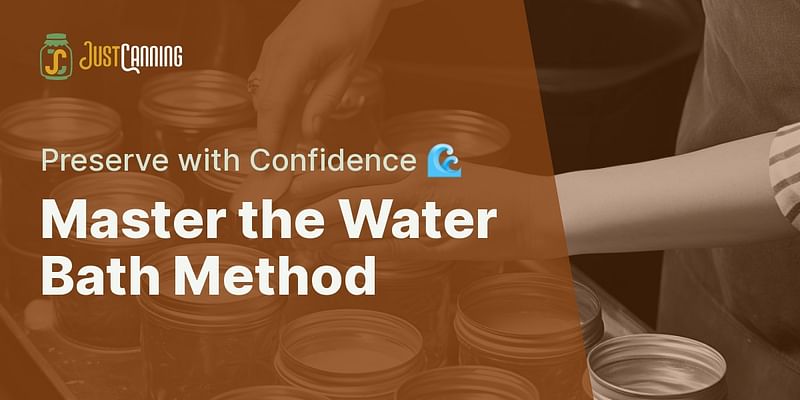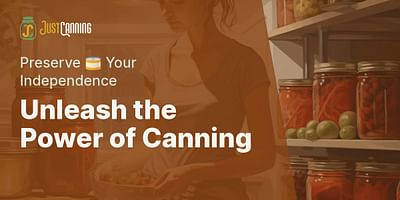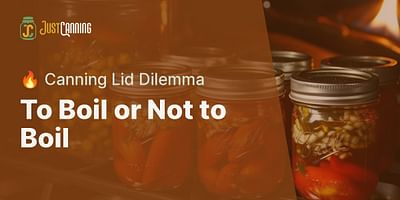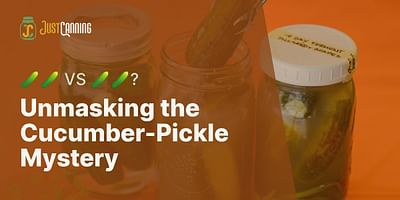Tom Bennett is a DIY enthusiast who loves to build and modify canning equipment. He enjoys writing about his projects and teaching others how to make their own canning tools.
Welcome to the world of canning! If you're new to this, you might be wondering, "What is water bath canning?" Simply put, it's a method of preserving high-acid foods like fruits, jams, jellies, and pickles. One of our favorites is canning onions water bath style!
The purpose of water bath canning is to kill the bacteria, yeasts, and molds that could spoil your food. It also helps to seal your jars, keeping your food fresh for longer. How does it work? It's all about heat! By submerging your jars in boiling water (hence the term boiling water bath canning), you're ensuring that the heat penetrates every part of the food, killing any microorganisms present.
Now, you might be wondering, "What's the difference between steam canning vs water bath canning?" The main difference is the source of the heat. While steam canning uses steam, water bath canning uses boiling water. Both methods are effective, but water bath canning is often preferred for its simplicity and versatility.
So, are you ready to dive into the world of water bath canning? Keep reading for a detailed water bath canning guide, complete with water bath canning recipes, and learn how to seal jars in a water bath like a pro!
Your DIY Journey: A Step-by-Step Guide to Mastering Water Bath Canning 🍅🥒
Step-by-Step Guide to Water Bath Canning
- Prepare Your Jars: Begin by thoroughly washing your canning jars, lids, and rings in warm, soapy water. Rinse them well to ensure no soap residue remains. Sterilize the jars by placing them in boiling water for 10 minutes.
- Prepare Your Food: Clean and chop your chosen food. Remember, water bath canning is best for high-acid foods like fruits, pickles, and tomatoes.
- Fill Your Jars: Pack your food into the jars, leaving appropriate headspace for expansion during processing. Pour in the preserving liquid (like vinegar, lemon juice, or syrup), again leaving the recommended headspace.
- Seal Your Jars: Wipe the rims of the jars with a clean cloth to remove any food debris. Position the lid and screw the band down until it's fingertip-tight.
- Process in Water Bath: Place your jars in the canner, ensuring they are completely submerged in water. Cover the canner and bring the water to a full rolling boil. Process for the recommended time based on your recipe and jar size.
- Remove and Cool: After processing, turn off the heat and carefully remove the jars using a jar lifter. Place them on a towel to cool for 12-24 hours. You'll hear a popping sound as the jars seal.
- Check the Seals: Once the jars are cool, check the seals by pressing the center of each lid. If it doesn't pop back, the jar is sealed. If it does, refrigerate and use that jar first.
- Store Your Jars: Finally, store your sealed jars in a cool, dark place. Remember to label and date each jar for future reference.

Now that you've seen the canning process in pictures, let's watch a video to further understand the process. This video by GrowVeg demonstrates the step-by-step process of water bath canning.
After watching this video, you should have a good grasp of how to perform a water bath for canning. Now, let's move on to some tips and troubleshooting advice to ensure your canning process goes smoothly.
Don't Sweat the Small Stuff: Tips and Troubleshooting for Your Water Bath Canning Adventures 🛠️🔍
So, you've made it through the water bath canning process. It wasn't that hard, right? Remember, practice makes perfect. Whether you're canning corn in a water bath or trying out new water bath canning recipes, the process remains the same. It's all about preparation, filling, sealing, and processing.
But what if things don't go as planned? Don't worry, it happens to the best of us. If your jars don't seal properly, it could be due to overfilling or a damaged jar rim. Simply try reprocessing the jar with a new lid or in a different jar. And if you notice your jars aren't fully submerged during the boiling water bath canning process, you might need to add more water or use a proper water bath canner. For more information on safe canning practices, check out our article on common canning mistakes and how to avoid them.
Remember, steam canning vs water bath canning are two different methods, each with their own pros and cons. Make sure to choose the method that best suits your needs and the type of food you're canning.
And there you have it, your guide to water bath canning. So, what are you waiting for? Grab your canning jar, roll up your sleeves, and start canning!















